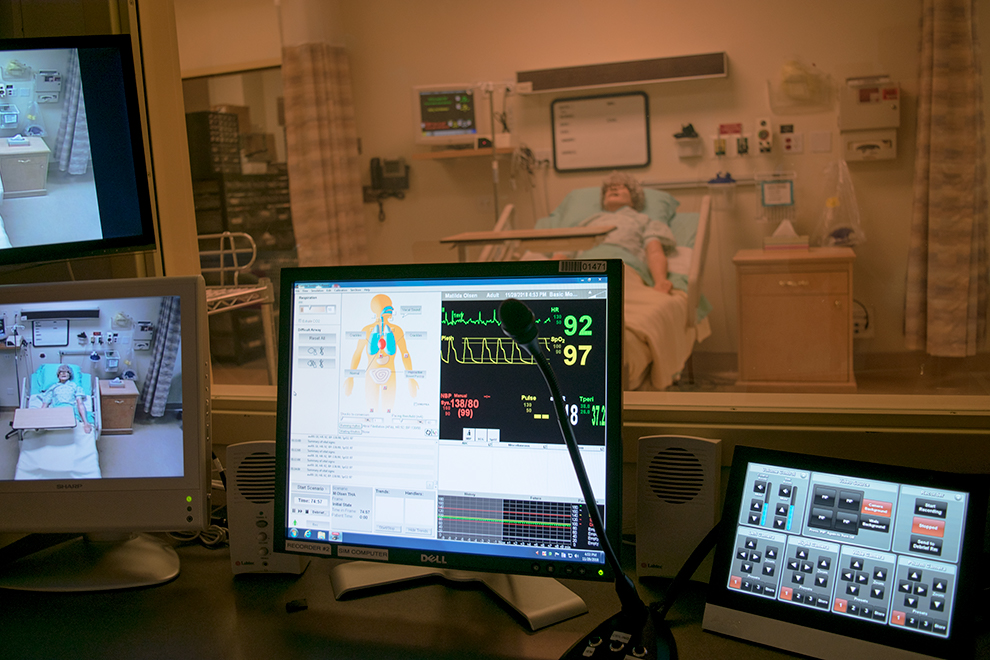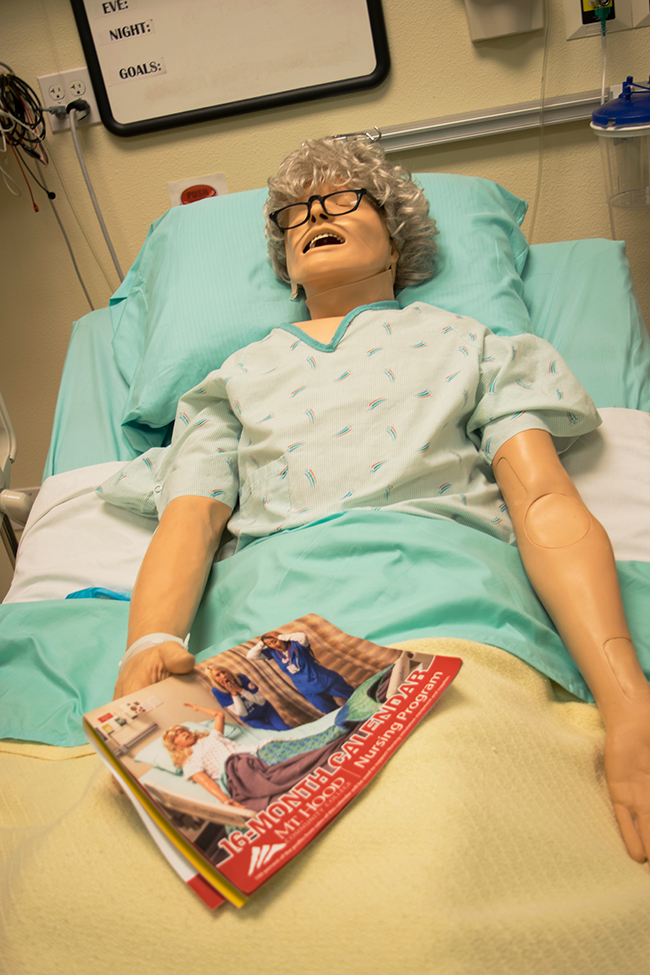NURSING PROGRAM RAISING FUNDS FOR NEW SUPPLIES

Photo by Shyann Tooke / the Advocate
As medical simulation leads the way in the education of nurses, Chrissy Bloome, longtime nursing instructor at Mt. Hood, works hard to make sure Saints students continue to receive the best schooling available to them.
The MHCC Bruning Center for Allied Health Education may be unfamiliar to most students, located near Gresham Station and apart from the main campus, but it’s a unique and historically important part of the college. The center opened in 2004 and was the first multi-room simulation lab in the state of Oregon.
“Simulation is one way that we help nurses get clinical experiences, so they can to learn how to be nurses. They go to classes, they do labs, and they learn skills,” said Bloome.
A visitor entering the simulation lab finds two hospital beds in a setting identical to an actual hospital room. The lab has everything needed for real scenarios. In each of the beds there is a high-tech manikin, called a “human patient simulator,” that can replicate sounds that nurses check for on actual patients, such as their breathing.
“We can manipulate all these different features to mimic certain human symptoms, diseases and conditions that nurses are going to see in real clinical settings,” explained Bloome.
While two students fill the role as nurses in the lab, the rest watch via live-stream from across the hall. When the exercise is finished, all students have a debrief about what went well, and where improvements could be made.
“We have an opportunity to learn from mistakes,” said Bloome. “It’s okay to have mistakes, but if there’s gonna be mistakes that happen, they happen here, so that when (students) take care of real patients they’re not making mistakes.”
This unusual set-up can cause added stress for students compared to a traditional classroom, because everyone watches and learns from each other. Bloome noticed this phenomenon, and worked to find ways to create a psychologically safe learning environment by studying how people react to stress, and how people react in simulation labs.
“I started putting together my own format of things and I started putting myself out there to other places, to start teaching this stuff,” she said.
Bloome’s passion has taken her around the world. A Mt. Hood instructor since 1992, she’s taught at the Swedish Medical Center in Seattle, the International Meeting on Simulation in Healthcare, and in Paris, Madrid, and Lisbon. She’s also been accepted to teach at the Human Patient Simulation Network World 2019 conference in Orlando.
Bloome teaches at these conferences on a voluntary basis and learns from other speakers, then returns to infuse what she’s learned into MHCC’s nursing program.
Keeping the simulation lab, and other important parts of the nursing program, going isn’t cheap, meantime.
“[Simulation] is a required part of our curriculum, and given that it’s required that means that we have to provide opportunities to learn,” said Bloome. “Having a steady operational budget to run this is a challenge for us. It’s a challenge for many simulation labs.”
That’s why she put in the time and effort to make it possible to hold fundraisers for the nursing program. The department’s first endeavor is a printed academic calendar that runs through 2019. It’s specific to MHCC, with appropriate registration dates, beginning and end-of-term dates, historical dates and fun facts. It also features health observance dates that are often relevant to college students.
The calendar has been nominated for the Council for Advancement and Support of Education (CASE) District 8 Awards.
Kim Poling, a Mt. Hood nursing student, joined in the making of the calendar. This was the year the Student Nurses Association, a student club,
decided to take the idea Bloome had harbored for awhile and make it happen, she said.
Poling said, “I’m really proud to see that it came about and it’s doing good,” praising the team effort to make it possible.
MHCC graphic design coordinator Glenn Wright helped take the photos. “It was such a great collaboration of creativity and Glenn even got in on it a little bit, too,” Poling said.
The program has set up an account to allow future fundraisers to support the nursing program, and to expand simulation as clinical placements in medical facilities become harder to come by, as more nursing programs pop up, said Bloome.

Photo by Shyann Tooke / the Advocate
“[Studies] have found that up to 50 percent of clinical time can be replaced with simulation,” she said. “We basically have a crisis in being able to get enough clinical spots for our students, so the bottom line is we have to do this, which also means (doing) all of the things that are involved to make it happen – trained faculty, equipment, supplies, creating scenarios, creating the whole learning opportunity.
“It takes time and it takes money,” she said. But the end result is worth it, she said.
“We want to provide the very best learning opportunities available for students. We want to provide the best opportunity compared to anywhere.”
Poling said she’s grateful for Bloome’s commitment to students.
“She’s an amazing person overall. She really is Mt. Hood,” Poling said.
Calendars are available for purchase through the end of December in the bookstore for $15, or online at mhcc.edu/simlab for pickup in the Student Union.

Leave a comment